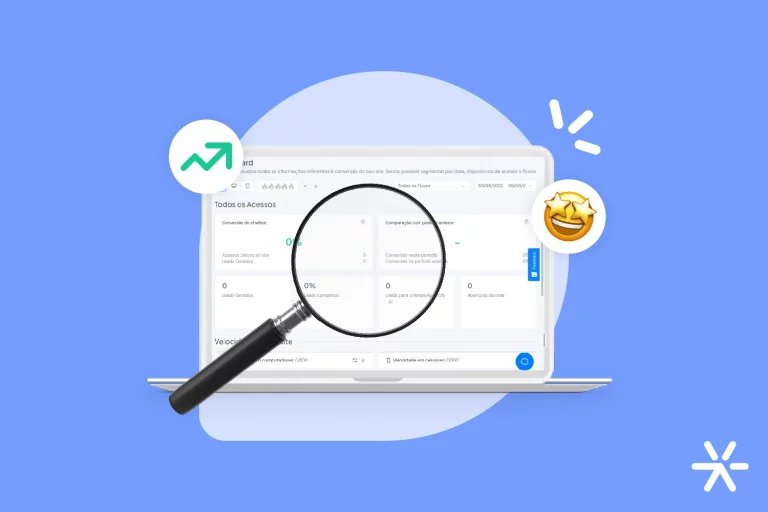The 20 Most Fundamental SaaS Metrics to Keep an Eye On
SaaS Metrics are a compass in a market known for not being the biggest fan of compasses—everything changes all the time, and often so fast that it’s hard to instinctively know where we’re headed.
This characteristic of the SaaS market and software development in general would be very difficult to deal with if it weren’t for a mindset that values results above all and knows well how to measure them.
SaaS metrics operate exactly on this principle—the market can change as much as it wants: we track everything with optimism, calmness, and security because we know where we stand and what our objectives are.
Come rain or shine, SaaS metrics are the business weather forecast for companies working with software as a service.
And by the way, that’s how we’re going to start the article today. What exactly is the SaaS market? And why does it need so many metrics and so much security?
Let’s find out together:
What Exactly is SaaS?

According to the Gartner Glossary, a SaaS software is “software that is delivered, managed, and owned by one or more providers.”
The company also adds that the provider delivers the software based on payment plans and through cloud computing services.
In other words, you pay to access the software, which is web-based and accessed through a browser. Hence the name software as a service (SaaS).
This model is completely different from how software was sold in the late 1990s and early 2000s. Back then, you needed to buy physical media with the program or download it.
Even in the last decade, after installation, you had to use a unique code, a serial key, to activate the application on a specific machine. Depending on your serial type, you could or could not install it on other machines.
The SaaS model completely revolutionized the market—installations are no longer necessary, and the program is not installed locally anymore. And now, instead of the serial key, the user can access the application through a single account.
The biggest revolution came from competition. This model is simpler and more democratic for companies, which had to consider other points to attract more users: UX Design, cheaper plans, partner commissions, etc.
Today, the SaaS model doesn’t just dominate the market. It is the market. And precisely because of this intense competition, SaaS companies need strong support in data.
Understanding KPIs, OKRs, and Metrics
This support in data is possible through the advanced monitoring methodology that SaaS companies bring in their DNA.
This is a legacy from the times when most SaaS companies were startups. In the early 2000s, the SaaS revolution in the corporate world began with startups like Salesforce, which launched the first SaaS CRM in history in 1999.
Startups follow the philosophy of growth marketing. In fact, they created the growth methods themselves. They need to closely monitor their results to understand the performance of their product and where it stands.
For startups, this tracking of results is 100% aligned with the philosophy of accelerated growth. Everyone fails and makes mistakes, and companies are no different. By monitoring results, startups could fail fast, correct, and move forward.
Okay, the history lesson is over. 😅 All of this was to say that startups created the growth model, and that metrics, KPIs, and OKRs are part of it.
This philosophy is still followed today by SaaS companies, whether they are startups or not. Let’s understand better what each term means.
What are SaaS Metrics?
SaaS metrics are extremely important information about the overall performance of the company.
Or they are extremely precise information on how the company is generating new customers.
Or indicators that show how the company is in relation to goals it sets as a plan to achieve success.
SaaS metrics are all this and more. It turns out that there are SaaS metrics for a multitude of measurements.
We can come to a common conclusion, however, that delimits all types of SaaS metrics: they are performance indicators of an area, the information that an area has about a certain action.
This “area” can be anything: sales, digital marketing, expansion, product development, performance marketing in paid media, activations, and so on.
What is the Difference Between Metrics and KPIs?
It’s a pretty big difference, even though in most conversations about SaaS metrics they are seen as synonyms for KPIs.
This is a very common mistake and, in most cases, completely harmless. In practice, this confusion doesn’t make much difference precisely because of the structure of KPIs.
But let’s get to the definition: SaaS metrics are general information about a particular area, without any effort at interpretation.
For example: today, 300 new leads were generated through paid media in your company.
Key Performance Indicators, or KPIs, are a little different. We call KPIs the indicators that come with an extra level of interpretation, which is provided by the company’s or sector’s key objectives.
Another example to simplify: the KPI “evolution of new leads through paid media” showed that the result of 300 new leads was positive because it had a growth rate of 100% compared to the previous month.
Metrics exist for every action you take. KPIs need to be formalized with key objectives to make sense.
You can create new KPIs, like this example, but there are many KPIs focusing on companies, products, and SaaS metrics already being used today.
Let’s include them in the list of SaaS metrics throughout the article, okay? But for now, we need to talk about OKRs, key elements for creating KPIs.
Follow along:
What Are OKRs?
OKRs are Objectives and Key Results. They provide the extra dimension of interpretation for metrics to become KPIs.
Without OKRs, any indicator your company has is a SaaS metric. But when you add them to the equation, these metrics become KPIs.
As we understand it so far, the difference between KPIs and metrics lies in this interpretation. A single piece of data is just that: data. When you relate it to an objective, it becomes an indicator.
Creating OKRs is the first step toward a data-driven strategy, meaning a strategy primarily based on data to make strategic decisions.
They are formed from defining the company’s overall objectives and indicate the most fundamental points for its success.
So now we understand the differences and similarities between KPIs, OKRs, and metrics, right?
We are then ready to continue our conversation. Keep reading to learn about the main SaaS metrics and the KPIs that accompany them.
The 7 Main Financial and Growth SaaS Metrics

Before we dive into any conversation about SaaS metrics, we need to make one point clear: in many instances, it’s impossible to talk about metrics without also discussing KPIs.
That’s because merely knowing the metrics won’t take you anywhere. They will arise in every action you take. Above all, they need to be interpreted.
And the best way to do that is through KPIs that help understand and quantify them.
This list would be much shorter if we didn’t add KPIs to it. For example, here are some SaaS metrics without the extra level of interpretation:
- Quantity of customers;
- Quantity of leads;
- Total sales in a semester;
- Quantity of visitors on your website;
- Quantity of views on YouTube, among others.
This analysis ends up being quite shallow, and it’s pointless to discuss these metrics now because, whether you’re reading this article or not, they will be apparent as soon as you start your operations.
Therefore, throughout the article, we’ll include fundamental KPIs that explain SaaS metrics more profoundly when necessary.
Starting now with financial metrics and purchase recurrence:
LTV – Lifetime Value
LTV is a KPI used to understand the value of a customer, or a group of customers, in relation to the time they stay with the SaaS contract.
Or, in technical terms, LTV is the value that the customer generates for the company during its lifecycle. Hence the name lifetime value.
There are several SaaS metrics that will compose LTV. The main ones, as you may imagine, are contract time (or lifecycle) and subscription value.
These metrics can be analyzed customer by customer or by a group of customers. For example: a SaaS software works on two fronts: as a B2B solution and as software for common people, B2C.
By calculating the average, the company can understand what the LTV of these two groups is. The corporate plan usually closes annual contracts, while B2C contracts are for three months.
From there, the company can make strategic decisions to increase the LTV of the B2C group and others to improve the B2B experience, which are its key customers.
The formula for calculating LTV is simple and takes into account the SaaS metrics mentioned above. Follow below:
LTV = Average spending x Number of yearly purchases X client lifecycle
❗ If you are not familiar with these metrics, don’t worry: we discuss all of them throughout the article.
MRR – Monthly Recurring Revenue
MRR is a SaaS metric that indicates the recurring revenue of your SaaS company.
This is important to measure because, in the vast majority of cases, SaaS contracts are made through subscriptions.
It is the MRR that basically indicates what the monthly revenue of your company is with the active contracts it maintains.
It is one of the simplest indicators to calculate. See the formula below:
MRR = Number of customers X earnings in the analyzed period.
ARR – Annual Recurring Revenue
ARR is very similar to MMR. In fact, the formulas are the same; what will change is the time you are analyzing.
In MMR, we analyze Monthly Recurring Revenue. In ARR, Annual Recurring Revenue.
The “monthly” and “annual” convention can be completely ignored when you are analyzing this SaaS metric.
You can do an SRR, for example, to analyze only the semester. Or TRR, to analyze the semester.
ARPU – Average Revenue per User
Another very important SaaS metric is ARPU, the average value per user.
It will indicate, in a general sense, how much each user contributes to your monthly recurring income, considering the subscription model.
It is easy to see that ARPU and MRR are almost talking about the same thing, but at a different level of analysis: MMR analyzes the entire month for all customers. ARPU analyzes the revenue brought in on average by just one user.
This distinction is very important for strategic decisions, especially when you expand this SaaS metric and seek to work it in different groups of customers, as we did above in LTV.
It also has enormous importance in various strategic decisions related to the user and their experience.
A higher ARPU justifies extra spending in the company, such as a chatbot to generate leads, greater investment in support, and new features for a product.
Here’s how to calculate this SaaS metric:
ARPU = MMR / Number of users

Churn Rate
The churn rate has one of the most interesting inspirations for its name.
Think about the guy making cotton candy. He’s stirring the sugar to put it on the stick, right? But not all the sugar stays on the stick: some of it remains on the edges.
It’s like that with any candy that needs a lot of stirring: some always stays on the edges and at the bottom of the pan. In English, this act of stirring the candy is called churn. And the churn rate is inspired by that candy left behind.
Basically, the Churn Rate is a SaaS metric that indicates how your customer retention is. It demonstrates the percentage of customers who sign up with you but eventually abandon the service and cancel it.
This is one of the most closely monitored SaaS metrics of all. The number of customers you are losing is as important to analyze as the number of customers you are gaining.
Some would even say it’s more important. Losing loyal customers has a direct impact on your LTV, as acquiring new customers is more costly than continuing the relationship with existing ones.
Its calculation is also simple:
Churn Rate = (Lost clients / Gained clients) X 100
Expansion Revenue
Expansion Revenue is a KPI that mainly deals with SaaS metrics indicating the percentage of upsell and cross-sell your sales team can achieve in a certain amount of time.
For those not familiar with the terms, a basic review:
- Upsell: the act of offering and closing a superior product to what the consumer was interested in or using at the moment;
- Cross-Sell: additional products sold to a consumer who was interested in only one.
These two sales techniques bring important SaaS metrics: quantity of Upsell and Cross-Sell in a specific period. But they don’t tell the whole story.
Through Expansion Revenue, these metrics are analyzed and presented differently: the percentage of expansion your revenue experiences.
The formula to calculate it is simple:
Expansion Revenue = S – (Sn + MMR)
S = Sales in a period of time
Sn = Sales to new clients
MMR = Monthly Recurring Revenue
Quick Ratio
Quick Ratio is a comparative SaaS metric. It seeks to compare new sources of revenue with lost opportunities. The basis of this calculation is your MRR.
This metric describes a very urgent need for SaaS companies: the need not only to generate new sources of revenue growth over a certain period but also to retain them in the company.
In other words: Quick Ratio is a metric that seeks to analyze not only growth but also the efficiency of growth. Is it sustainable? For how long? When does it become unsustainable?
This is a very advanced metric and requires an active and close CFO — chief financial officer — for its implementation to work well.
It involves other more in-depth dimensions of your MRR, which requires a well-organized description of this complementary metric.
See more directly in the formula:
Quick Ratio = nMMR + eMMR / crMMR + ctMMR
nMMR = New client’s MMR;
eMMR = Upsell MMR;
crMMR = Churn-lost MMR;
ctMMR = Plan downgrade MMR (Contraction MMR).
The 7 Main SaaS Metrics About Marketing
If you’re feeling a little overwhelmed with so much financial information, don’t worry, the worst is over.
SaaS metrics dealing with financial aspects are the most complicated to handle. In many cases, they are as complex as complete KPIs from other areas, as you will see here in marketing.
These financial metrics, however, cannot be ignored at all. All calculations need to be made in advance to avoid surprises in the future and for your SaaS company to grow in a scalable manner.
And speaking of growth, now we need to talk more about metrics related to marketing, which are also very important.
We talked a lot in the previous section about growth, new customers, recurring customers, customers who cancel, etc. Now we need to talk about acquiring them. Let’s go?
Unique Monthly Visitors
This is a simple metric that comes ready for you in Google Analytics. So, at least for now, there won’t be any formula or math involved 🥲
Unique Monthly Visitors indicate how many people accessed your website in that month. But be careful: recurring people, who access more than once a month, count only as one visitor, okay?
To know this result, it’s simple. First, open Google Analytics and click on the “Acquisition” tab, then on “Overview”. There you go: your unique visitors are expressed as “New Users” within the period you set.
Registrations and Leads
The next step is to understand how your SaaS lead generation metrics are doing. This is also quite simple, but it depends on the tool you use for grouping these leads.
For example: in the case of Leadster, the number of leads is the first piece of information that appears on your home page:
Other more advanced settings are also possible, such as exporting the list of leads (complete or by period) and an automatic email report with new conversions within a period.
If you don’t have such a platform and collect leads in a spreadsheet, the work becomes much harder. You need to organize them beforehand or create specific functions to track progress in real-time.
Visitor to Lead Conversion Rate
This is the natural evolution of the combination of these two metrics. The Top of the Marketing and Sales Funnel has three main concerns:
The number of visitors; The number of leads; The conversion rate from visitors to leads.
To analyze the KPI completely, you need to master these three metrics at the same time.
This is because generating visitors but not generating leads is a waste of work. And knowing the number of leads without knowing the number of visitors doesn’t tell the whole story.
Above, we used the example of 300 leads per month. If you’re generating 30,000 general visits per month, then your VTL is 10% — that is, one out of every ten visitors converts into a lead.
But if you’re generating 60,000 visits per month, 300 leads represent a VTL of 0.5%, a quite different and below-average rate in Brazil.
It’s very important to keep an eye on the VTL rate of the Brazilian market in general — and of course, your segment’s as well.
The example I gave above is quite straightforward and simple — a variation of one decimal place. But you might have a VTL of 2% while the average in your segment is 4.5%, for example.
That’s the importance of benchmarking the VTL rate of the market: knowing where your company stands.
LVR – Lead Velocity Rate
This is a slightly more difficult metric to calculate and understand. LVR is related to the evolution of qualified leads over a certain period compared to another, usually month to month.
It seems difficult, but it’s not that much. This rate shows the evolution of your base of qualified leads coming to sales when comparing two periods.
To find it, simply subtract the number of leads this month from the number of leads from last month. Then, divide the result by the number of leads from last month and multiply by 100 to get the percentage.
For example: last month, 200 qualified leads arrived for the sales team. This month, 230. Doing the math, your lead velocity rate is 13%.
This SaaS metric is important to understand the fate your leads are having. It also helps in assessing the performance of your sales team.
In many companies, there’s a clash between marketing and sales teams from time to time. Sales say marketing isn’t generating leads. Marketing says sales aren’t able to close the generated leads.
LVR ends this discussion. By comparing month to month, you can understand the evolution of your lead qualification. In addition to measuring marketing efficiency, you also have a great guideline to visualize the next quarters.
See the formula below:
Lma = Leads of the current month
Lmp = Leads of the previous month
LVR = (Lma – Lmp / Lmp) X 100
Paid ROI vs. Organic ROI
ROI — Return on Investment — is the most popular of SaaS metrics. Many people know what it is, and those who don’t can understand it directly from the name.
Its calculation is also simple: ROI is measured by subtracting the results obtained in contracts (i.e., the value of these contracts) from the amount invested to close them.
In marketing, however, it’s crucial to make a very important distinction: there’s a drastic difference between paid media and organic traffic.
Paid media refers to advertisements on Google Ads or Social Ads platforms: Meta, LinkedIn, YouTube, TikTok, etc.
Organic traffic, on the other hand, indicates visitors who come to your site not through ads but organically: through your blog to generate leads, unsponsored posts on social media, YouTube videos, live streams, etc.
Many people end up thinking that organic traffic is free while paid media brings paid traffic. The latter is true, but organic traffic isn’t free.
You need to spend on good writers, develop topics and posts, have a designer, have a videomaker, and so on: the costs are not simple, and the return may take time.
The difference is that organic traffic remains, while paid media brings traffic as long as you continue to invest in them.
There’s no better or worse: they are two different marketing methodologies. You need to analyze in which one you are spending more through ROI.
This you can do month by month with paid media. With organic traffic, you need to wait for the first results to arrive, and only then calculate a real ROI.
Customer Conversion Rate (CCR)
The CCR conversion rate is closely related to LVR, being part of the complete analysis of KPIs indicating the number of sales per leads for your SaaS company.
The CCR rate indicates the conversion rate from leads to customers or from visitors to customers. In other words, how many people enter your marketing radar — your Sales Funnel — and leave it as customers.
This metric helps to understand the health of your Funnel. Without it, you’re in the dark, not knowing what’s happening with your leads after conversion, nor what you can do to have more leads close and fewer give up.
Number of Activations
The last marketing-related SaaS metric we’ll discuss now is very popular in startups and SaaS companies that follow the Salesforce model of operations.
More than just selling, it’s important to know if customers are actually using the platform.
This is because customers who are actively using your product are less likely to become just another dot in your churn.
A positive number of activations is usually a metric indicating a good MRR and ARR. This metric is closely monitored by the support and sales teams.
An activation is the term most used to define the number of complete implementations of your system you’ve done in a certain period.
These implementations usually include all the onboarding steps of your product. Your customer closed, and now what? Typically, a few meetings are needed for them to understand how the system works, how to register users, etc.
That’s what the number of activations checks: the number of implementation processes of your system that the support team has done with the customer.
It doesn’t have a formula, but a CRM is essential to track its development.
The 6 Key SaaS Sales Metrics
Here at the end of the article, we couldn’t fail to mention the SaaS metrics related to your company’s sales.
These metrics are very, very important for your strategy. Through them, it’s possible to understand many points, both current and future.
You must have noticed that some marketing metrics and KPIs are closely related to sales. This is common, normal, and quite expected, especially when you put inbound marketing into practice.
In modern digital marketing, the distinction between the marketing team and the sales team is becoming increasingly smaller. Both work together because both have the same goal: generate more sales.
With that in mind, let’s take a look at some more SaaS metrics related to sales?
Number of MQLs, SQLs, and PQLs
This first metric should always be on the tip of the tongue of any marketing manager and any sales director.
MQLs, SQLs, and PQLs indicate the level of maturity of a potential customer regarding your sales process. See what each of them means:
- MQL: Marketing Qualified Lead. They have already gone through all the initial stages of the Funnel, the Top, and the Middle;
- SQL: Sales Qualified Lead. They have already had an initial approach from a sales representative and are ready to receive a demo;
- PQL: Product Qualified Lead. They have gone through the two stages above (or went straight to this one) and have already done the product demo. They are ready to receive a proposal.
The number of leads at each stage helps you understand where the main bottlenecks of your strategy are. And it also helps you understand the evolution of MRR throughout the year.
Conversions by Marketing Funnel Stage
Those who work with the Marketing Funnel — practically all SaaS companies — need to understand how conversions are going at each of its stages and the Customer Journey.
Remember: the Marketing Funnel and the Customer Journey are different perspectives. The Funnel is a corporate view, while the Journey is how the consumer himself makes his purchase decision.
The Funnel has three stages, related to lead generation and their conversion into MQLs for qualification with the sales team:
- Top of Funnel: visitors to your site who still don’t know much about your brand and reached you through searches or ads, usually related to a shared topic of interest;
- Middle of Funnel: people who have converted into leads and are in the segmentation and nurturing process;
- Bottom of Funnel: people who have already gone through the more open phases of the Funnel or arrived on your site through targeted ads related to your product. They are the most likely to buy and are closer to becoming MQLs.
Each of these stages has its own triggers — in the links, you can follow what they are.
It’s necessary to measure the number of leads at each of these stages to understand where your bottlenecks are and act on them. And also to know where it’s necessary to invest more and work on your CRO.
LTC – Lead to Close Rate
Another simple but very important metric to calculate is the Lead to Close Rate, or Sales Conversion Rate.
We’ve already talked a lot about conversion rates throughout the text, and this is another example of measuring the efforts made by the sales team to close the leads generated by the marketing team.
Calculating it is simple: just subtract the number of sales from the total number of leads. But with a caveat: only sales generated from these leads should be included in the count.
For example: if you have a direct outbound marketing strategy, with representatives visiting people or establishments, you cannot include those sales in the same count.
CAC and CPP – Customer Acquisition Cost and CAC Payback Period
This is one of the most important metrics for your company. And due to its multidisciplinary nature, it can even be considered a KPI.
CAC is the Customer Acquisition Cost. It’s basically how much you spend to generate a new sale in your company.
This calculation is difficult to make. You need to add up all your marketing investments and then divide by the number of sales generated in a period.
The difficulty lies precisely in understanding what these expenses are. Should customers generated through paid media cover the cost of organic traffic?
What companies usually do is put all investments into one basket, and then divide by all customers generated in the period being analyzed, without exceptions.
The CAC Payback Period is a KPI that shows how long it will take for a customer generated with the determined CAC to have a positive ROI.
For example: your CAC is $200. How long does it take for this CAC to turn into profit according to your MRR?
That sentence itself is the formula. To understand the CPP, simply divide your CAC by your MRR.
Improve Your SaaS Metrics with a Chatbot for Lead Generation
Many of these metrics, especially those related to lead generation, are much better with the support of a Chatbot on your website.
Imagine that, for every visitor, you could send a personalized message that recognizes not only what the visitor is reading but also where they came from?
It’s impossible to do this with human assistance. But for a Chatbot, it’s just another Monday.
And all this while you can also measure the number of leads you are generating through the chatbot and integrate them into the main marketing management software.
Measuring SaaS metrics related to leads is much better with good news every day, don’t you think?








